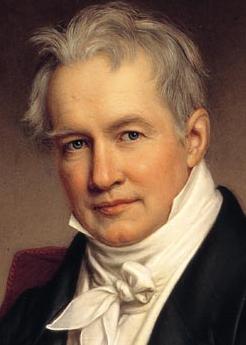| Alexander von Humboldt | |
|---|---|
 |
|
| Geographer & Explorer | |
| Specialty: | Geography |
| Born | Sep. 14, 1769 Berlin |
| Died | May 6, 1859 (aged 89) Berlin |
| Nationality | Prussian |
Alexander Von Humboldt was a German naturalist and explorer. He was the major figure in the classical period of physical geography and bio-geography. He was the younger brother of Wilhelm Von Humboldt, the Prussian minister and philosopher. His works on botanical geography formed a foundation for the field of bio-geography.
Early Life
Alexander was born in Berlin, Germany on September 14, 1769. His father was an army officer who died when Alexander was nine years old. After the death of his father, they were raised by their cold and distant mother. He was taught by tutors at an early age; this was grounded in mathematics and languages.
When Alexander was old enough, he started to study at Freiberg Academy of Mines. This was under the famous geologist called A.G Werner. While still in school he met George Forester who was Captain Cook’s scientific illustrator from his second voyage. They both hiked around Europe. At the age of 22, in 1792, he got a job as a government mine inspector in Franconia, Prussia. When he was 27 years old, his mother passed away, leaving him an income from their estate.
Early Career
Between the years 1799 and 1804, he traveled all over Latin America. He explored and described these areas for the very first time from a modern scientific point of view. A detailed description of his journey was written and published in a set of volumes over 21 years.
He was one amongst the first person to propose that lands bordering the Atlantic Ocean were at one point joined to Africa and South America. Years later, his five- volume work entitled Kosmos (1845), tried to unify the several branches of scientific knowledge. Alexander supported and worked with several other scientists such as Louis Agassiz, Georg von Neumayer, Justus von Liebig and Joseph Gay-Lussac.
Exploring South America
After the death of his mother, von Humboldt worked for one more year and then resigned. He began to plan travels with a botanist named Aime Bonpland. Both of them went to Madrid and managed to get permission and passports from King Charles II to travel and explore South America. When they arrived in South America, they decided to study the flora, topography, and fauna of this continent. In 1800, Alexander Von Humboldt mapped more than 1700 miles of Orinco River.
This was later followed by a short trip to the Andes and a climb of Mt. Chimborazo. However, they did not make it to the top since they encountered a wall-like cliff. They only managed to climb 18,000 feet in elevation. At the west coast of South America, Alexander measured and also discovered the Peruvian Current (also known as the Humboldt Current). In 1803, they explored Mexico. Alexander was even offered a job in the Mexican cabinet but refused.
Other Works
In 1804, Alexander Von Humboldt went to Paris. He wrote 30 volumes of his field studies. During his explorations in America and Europe, he kept a record and reported on magnetic declination. He stayed in France for about 23 years, where he met many other intellectuals. In 1827, he returned to Berlin where he worked as the advisory to King of Prussia.
Time in Russia
Alexander von Humboldt was later invited to Russia. After exploring Russia and describing major discoveries such as permafrost, he gave recommendations that Russia should establish weather observatories across this country. In 1835, stations were established and he Alexander von Humboldt was able to use this data to come up with the principle of continentality.
The principle said that the interiors of continents have much more extreme climates because of the lack of moderating influence from the ocean. Alexander also created the first isotherm map which contained lines of equal average temperatures.
Later Years
For one year between 1827 and 1828, Alexander gave public lectures in Berlin. The lectures were very popular such that new assembly halls were found due to the rising demand. As Alexander von Humboldt grew older, he wrote everything known about the earth. This work was called Kosmos and the very first volume was published in 1845. This volume sold out in two months and was even translated into many languages. The other volumes were about various topics such as the human effort to describe the earth, astronomy and human and earth interaction. In 1859, Alexander died and his fifth and final volume was published in 1862.